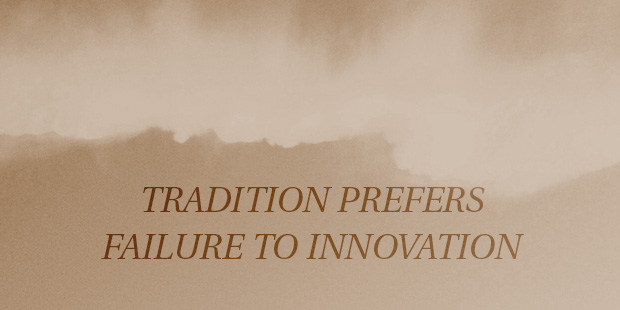
How to See Beyond Today: Acknowledge the Paradox of Expertise
It has been said that all leaders live under the same sky, but not all view the same horizon. Some leaders see a wider horizon and keep their eye on the emerging skyline. Continual learning contributes to their sense of adventure and their ability to steer their organization. Others, however, unknowingly wear blinders. The shifting horizons don’t signal new opportunities because they are unanticipated and out of view.
In this sense, strategic planning is often limited because it keeps blinders on leadership. Auxano founder Will Mancini calls this “fallacy of predictability.” The assumption is that the near future will resemble the recent past. But rapid cultural change has meddled with this assumption. Change now happens so fast that the planning processes of yesteryear are obsolete. Unfortunately, not even the future is what it used to be.
If the North American church is going to avoid the slow but sure death guaranteed by “we’ve always done it that way,” it will have to shift its understanding of both the past that was and the future that is not going to be more of the same.
According to Reggie McNeal, the churches that prepare for the new world will ride the wave of the growth that is possible. Those who don’t prepare will continue to plan their way into cultural irrelevance, methodological obsolescence, and missional ineffectiveness in terms of being kingdom outposts.
THE QUICK SUMMARY – Simply Brilliant by William C. Taylor
Far away from Silicon Valley, in familiar, traditional, even unglamorous fields, ordinary people are unleashing extraordinary advances that amaze customers, energize employees, and create huge economic value. Their secret? They understand that the work of inventing the future doesn’t just belong to geeks designing mobile apps and virtual-reality headsets, or to social-media entrepreneurs hoping to launch the next Facebook. Some of today’s most compelling organizations are doing brilliant things in simple settings such as retail banks, office cleaning companies, department stores, small hospitals, and auto dealerships.
William C. Taylor, cofounder of Fast Company and best-selling author of Practically Radical, traveled thousands of miles to visit these hotbeds of simple brilliance and unearth the principles and practices behind their success. He offers fascinating case studies and powerful lessons that you can apply to do ordinary things in extraordinary ways, regardless of your industry or profession.
As Taylor writes: “The story of this book, its message for leaders who aim to do something important and build something great, is both simple and subversive: In a time of wrenching disruptions and exhilarating advances, of unrelenting turmoil and unlimited promise, the future is open to everybody. The thrill of breakthrough creativity and breakaway performance . . . can be summoned in all sorts of industries and all walks of life, if leaders can reimagine what’s possible in their fields.” Simply Brilliant shows you how.
A SIMPLE SOLUTION
Most artists look for something fresh to paint; frankly I find that quite boring. For me it is much more exciting to find fresh meaning in something familiar. -Andrew Wyeth
Andrew Wyeth did not look constantly for fresh things to paint; rather, he was excited to find fresh meaning in things that were familiar. The beginning point in ascertaining vision is nothing less than the work of scrutinizing the obvious.
This represents a paradigm shift for leaders. Many leaders see what is, and accept it without looking for deeper or newer meanings. When leaders are “successful” at something, the tendency is to move on to the next thing. After all, you don’t mess with success.
Expertise is powerful…until it gets in the way of innovation. In a world being remade before our eyes, leaders who make a big difference are the ones who challenge the logic of their field – and of their own success.
One of the sobering lessons of the great transformations in business, leadership, and society in the last few decades is that the people and organizations with the most experience, knowledge, and resources in a particular field are often the last ones to see and seize opportunities for something dramatically new.
The storyline has become so familiar that the questions almost answer themselves: All too often, what we know limits what we can imagine.
Cynthia Barton Rabe, a former innovation strategist at Intel, coined a memorable term to describe this debilitating form of strategic blindness. Too may companies and leaders, often the best companies and most successful leaders, struggle with what she calls the “paradox of expertise” – the frustrating reality that the more deeply immersed you are in a market, a product category, or a technology, the harder it becomes to open your mind to new models that may reshape everything. Past results may not be the enemy of subsequent breakthroughs, but they can constrain the capacity to grasp the future.
In other words, the more closely you’ve looked at the field, and the longer you’ve been looking at it in the same way, the more difficult it can be to see new patterns, prospects, or possibilities.
There is a more sustained way to transcend the paradox of expertise, a mindset that draws on the best of what’s come before without closing off what may come next. It’s called “provocative competence,” and it comes from the world of jazz.
William C. Taylor, Simply Brilliant
A NEXT STEP
In his captivating book “Yes to the Mess,” Frank J. Barrett combines his accomplishment as a jazz musician with a background in teaching at the Naval Postgraduate School. In drawing all sorts of leadership lessons from jazz, Barrett states that so-so musicians allow themselves to fall into the competency trap by “relying on licks that have been greeted enthusiastically in past performances, to become in effect imitations of themselves.”
Great musicians manage to “outwit their learned habits by putting themselves in unfamiliar musical situations demanding novel responses.” According to Barrett, provocative competence is “leadership that enlivens activity and rouses the mind to life.”
In jazz, as well as on your church team, we need leaders who do this—men and women who support imaginative leaps, who can create a context that enhances creative possibilities and triggers glimpses, sudden insights, bold speculation, imaginative ventures, and a willingness (even an insistence) that people explore new possibilities before there is certainty and before they fully comprehend the meaning of what they are doing.
Schedule a future team meeting and walk through the five elements of “provocative competence” by discussing the following:
- Provocative competence is an affirmative move. The leader must first hold a positive image of what others are capable of. This often means seeing other people’s strengths better than they see their own strengths. It’s important to create a holding culture, an environment that provides enough stability and reassurance so that people know there is a safety net, someone to watch their backs as they branch out.
- Provocative competence involves introducing a small disruption to routine. It is an art to introduce just enough unusual material or thought that it engages people to be mindful – to pay attention in new ways. Timing is critical: Too much disruption on a regular basis will cause it to soon be ignored; too little would seem to be just a stunt.
- Provocative competence creates situations that demand activity. Leaders push their teams to try and try again to keep trying and discovering as they go. There’s not “sitting this one out” or taking a break to figure everything out.
- Provocative competence facilitates incremental reorientation by encouraging repetition. Think of it as a comfort zone – but not one that is too comfortable. Even while people are leaning on old habits, they have to attend to new options, and start to manage and process information within a newer, broader context.
- Provocative competence is analogic sharpening of perspectives and thought processes. Your team should start to make parallel links with seemingly unrelated contexts and see linkages between seemingly disparate ideas.
Saying, “yes to the mess” means finding affirmation in the best of what already exists. Every group, every individual has some strength, some moment of exceptional performance that has the potential to make a difference at some point. Truly gifted leaders—those who practice and exhibit provocative competence—are able to uncover this potential even when it is well hidden, even when the individuals in question can’t see it in themselves.
Excerpt taken from SUMS Remix 110-2, released January 2019
This is part of a weekly series posting excerpts from one of the most innovative content sources in the church world: SUMS Remix book excerpts for church leaders.
SUMS Remix takes a practical problem in the church and looks at it with three solutions; each solution is taken from a different book. Additionally, a practical action step is included with each solution.
As a church leader you get to scan relevant books based on practical tools and solutions to real ministry problems, not just by the cover of the book. Each post will have the edition number which shows the year and what number it is in the overall sequence. (SUMS Remix provides 26 issues per year, delivered every other week to your inbox).
>> Subscribe to SUMS Remix <<

Tags: Innovation, Planning, SUMS Remix, Simply Brilliant, William C. Taylor





























